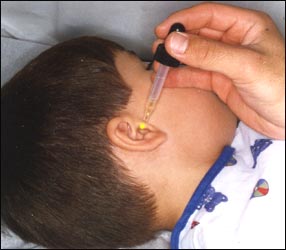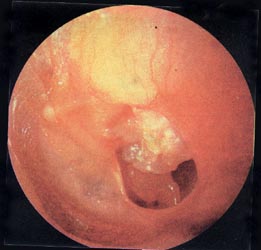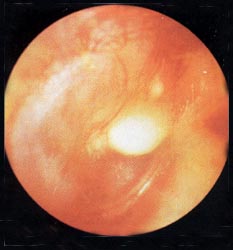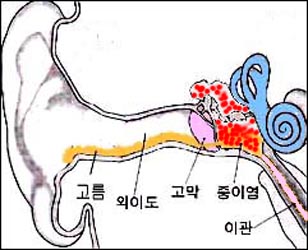만성 중이염, Chronic otitis media

사진 58. 외이도 속이나 중이강 속에 항생제 귀 방울약을 넣을 때.
Copyright ⓒ 2013 John Sangwon Lee, M.D. FAAP
- 급성 중이염이나 재발성 중이염을 적절히 치료받지 않고 오랫동안 방치하거나 급성 재발성 중이염을 적절히 치료받았지만 여러 가지 이유로 완전히 치료되지 않았을 때 급성 중이염이나 재발성 중이염이 만성 중이염으로 이어질 수 있다.
- 급성 중이염이 있을 때도 고막이 뚫릴 수 있다. 그러나 급성 중이염을 적절히 치료하면 뚫린 고막이 곧 막히는 것이 보통이다.
- 그렇지만 고막이 뚫려 있는 급성 중이염이 완전히 치료되지 않은 상태에서 만성 중이염으로 이어될 수 있다.
- 뚫린 고막이 있는 만성 중이염은 항생제치료 등 비 외과적 치료로 적절히 잘 치료가 되지 않을 때가 많다.
- 만성 중이염으로 뚫린 고막을 막아주는 외과적 치료를 하지 않는 한 뚫린 고막의 구멍은 쉽게 막히지 않는 것이 보통이다.
- 만성 중이염이 있는 상태에 거기다가 급성 중이염이 생기면 뚫린 고막 구멍을 통해 중이 강 속에서→ 외이도 속→귓구멍 밖으로 고름이 장기간 흘러나올 수 있다.
- 이렇게 오랫동안 지속된 중이염을 만성 중이염, 또는 재발성 중이염이라고 한다.
만성 중이염의 원인
- 만성 중이염을 일으키는 박테리아의 종류는 급성 중이염을 일으키는 박테리아의 종류와 거의 같을 수도 있고 아주 다를 수 있다.
- 프로테우스균(Proteus), 슈도모나스균(녹농균/Pseudomonas aeruginosa ) 또는 그 외 다른 박테리아 감염으로 만성 중이염이 생길 수 있다.
- 요즘, 급성 중이염이 항생제로 적절히 잘 치료되기 때문에 만성 중이염은 보기 드문 병이다.
- 만성 중이염이 있을 때 진주종(Cholesteatoma)이 생길 수 있다.
만성 중이염의 증상 징후
- 만성 중이염의 증상 징후는 다양하다.
- 흔히 볼 수 있는 증상 징후는 다음과 같다.
- 급성 중이염으로 고막이 뚫려 고막에 구멍이 생겨도 그 급성 중이염이 잘 치료되면 고막에 생긴 구멍이 곧 막히지만, 만성 중이염으로 뚫린 고막 구멍의 대부분은 내과적으로 잘 치료해도 고막 구멍이 잘 막히지 않는 것이 보통이다.
- 만성 중이염에다 급성 중이염이 또다시 생기면 짙고 누렇고 고약한 냄새가 나는 고름이 뚫린 고막의 구멍을 통해 중이 강 속에서 외이도 속으로 흘러나올 수 있다.
- 이미 있던 만성 중이염에 새로 생긴 급성 중이염을 적절히 치료하면 그때 생긴 급성 중이염은 다 나을 수 있지만 원래 있던 만성 중이염은 완치되지 않는 것이 보통이다.
- 만성 중이염을 속히 적절히 치료해 주지 않으면 만성 중이염을 일으킨 세균이 중이 강 주위에 있는 유양돌기나 측두골 등에 감염될 수 있다.
- 그래서 급성으로, 또는 만성으로 유양돌기염, 미로염, 양부 추체염, 뇌막염, 정맥동 혈전증, 뇌농양 등 합병증이 생길 수 있다. 그리고 청력장애가 생겨 난청이 생길 수 있다.
- 만성 중이염의 초기에 청력장애가 생길 수 있다. 그 외 별 증상이 없을 때도 있다.
- 감기나 다른 종류의 바이러스성 상·하기도 염에 걸리면 만성 중이염에다 급성 중이염에 걸릴 수 있고 만성 중이염이 더 심해지기도 하고 고름이 외이도 속으로 더 많이 흘러나올 수 있다.
- 이 때 생긴 만성 중이염을 적절히 치료해 주지 않으면 만성 중이염이 계속 더 나빠지고 결국에는 청력이 완전히 상실될 수 있다.

사진 60. 이경으로 외이도 속을 통해 본 진주종과 고막천공.
출처- Otitis media, Roche laboratories

사진 61. 만성 중이염과 중이강 속에 생긴 진주종.
출처- Otitis media, Roche laboratories
만성 중이염의 진단
- 병력, 증상 징후와 진찰소견 등을 종합하여 쉽게 진단할 수 있다.
- 아토피성 체질을 가진 아이들이나 아토피성 피부염이나 기관지 천식, 알레르기성 비염 등의 병력이 있는 아이들에게 재발성 중이염이나 만성 중이염이 더 잘 생길 수 있다.
- 그런 병력이 있으면 진단하는 데 도움 된다.

그림 59. 만성 중이염.
누런 고름이 중이강 속에서 외이도 속으로 흘러나온다.
Copyright ⓒ 2013 John Sangwon Lee, M.D. FAAP
만성 중이염의 치료
- 만성 중이염이 적절한 항생제로 적절히 치료될 때는 중이 강 속에서 고름이 더 이상 나오지 않고 다 나은 것 같다가 얼마 후 또다시 재발되는 것이 보통이다.
- 만성 중이염이 있는 아이들이 감기나 바이러스성 상·하기도염 등을 앓을 때 만성 중이염에다 급성 중이염이 동시 재발되어 앓게 될 수 있다.
- 이 때 생긴 급성 중이염을 적절한 항생제로 치료해 주면 그 급성 중이염은 잘 낫지만 원래부터 만성으로 있었던 만성 중이염은 완전히 낫지 않는 것이 보통이다.
- 귀젖이 나는 만성 중이염은
-
- 외이도 내 있는 분비물을 흡인 제거 치료를 하거나 외이도 내 흡수 심지로 분비물을 흡수 치료하거나 Q-Tip으로 분비물을 제거 치료 하고
- Ciprofloxacin(0.3%)+dexamethasone (0.1%) 4 방울 1일 2회 7일 간 치료 하고 경구용 Amoxicillin(600 mg) plus clavulanic acid으로 10일간 치료 한 결과 치료효과가 가장 좋았다.
- Pseudomonas균 감염으로 생긴 만성 중이염은 의사의 처방에 따라 Polymixin/neomycin/hydrocortisone 귀점적약제로 치료할 수 있다.
- 고막이 뚫린 만성 중이염은 뚫린 고막 구멍을 고막 이식수술로 막아주고 적절한 약물로 치료해야 비로소 완치될 수 있는 것이 보통이다.
- 급성 중이염이 만성 중이염으로 진행되지 않도록 급성 중이염을 조기에 적절히 치료해 주는 것이 상당히 중요하다.
Chronic otitis media

Picture 58. When antibiotic ear drops are placed into the ear canal or middle ear cavity. Copyright ⓒ 2013 John Sangwon Lee, M.D. FAAP
• Acute otitis media or recurrent otitis media can lead to chronic otitis media when left untreated for a long time or when acute recurrent otitis media is properly treated but not completely cured for various reasons.
• Even with acute otitis media, the eardrum may puncture. However, with proper treatment of acute otitis media, it is common for the perforated eardrum to become clogged immediately.
• However, acute otitis media with a perforated eardrum can lead to chronic otitis media without being completely cured.
• Chronic otitis media with a perforated eardrum is often not properly treated with non-surgical treatments such as antibiotics.
• It is normal for a perforated eardrum to not be easily clogged unless surgical treatment is performed to close the perforated eardrum due to chronic otitis media.
• If you have chronic otitis media and acute otitis media, pus may flow out of the middle ear cavity → the external auditory meatus → out of the ear canal for a long period of time through the hole in the eardrum.
• Otitis media that lasts for such a long time is called chronic otitis media or recurrent otitis media.
Causes of chronic otitis media
• The type of bacteria that causes chronic otitis media may be about the same as or very different from the type of bacteria that causes acute otitis media.
• Chronic otitis media can be caused by infection with Proteus, Pseudomonas aeruginosa or other bacteria.
• Chronic otitis media is a rare disease these days because acute otitis media is adequately treated with antibiotics.
• If you have chronic otitis media, you may develop cholesteatoma.
Symptoms, signs of chronic otitis media
• Symptoms, signs of chronic otitis media vary widely.
• Common symptoms and signs are as follows.
• Even if the eardrum is perforated due to acute otitis media, the hole in the eardrum is immediately blocked if the acute otitis media is well treated. to be.
• If acute otitis media occurs again in addition to chronic otitis media, pus with a thick, yellowish, foul-smelling odor may flow from the middle ear cavity into the external auditory meatus through the hole in the tympanic membrane.
If new acute otitis media is properly treated for existing chronic otitis media, then acute otitis media can be cured, but the original chronic otitis media is usually not cured.
• If chronic otitis media is not treated promptly, the bacteria causing chronic otitis media may infect the mastoid process or temporal bone around the middle ear cavity.
• So, acute or chronic complications such as mastitis, labyrinthitis, parietal pyloritis, meningitis, venous sinus thrombosis, and brain abscess may occur. And hearing loss can lead to hearing loss.
• Hearing impairment may occur in the early stages of chronic otitis media. Sometimes there are no other symptoms.
• A cold or other viral upper respiratory tract infections can cause chronic otitis media as well as acute otitis media, which can make chronic otitis media more severe and cause more pus to drain into the ear canal.
• If chronic otitis media is not properly treated, chronic otitis media can get worse and eventually lead to complete hearing loss.

Photo 60. Cholesteatoma and perforation of the tympanic membrane seen through the auditory canal through the otoscope. Source- Otitis media, Roche laboratories

Picture 61. Chronic otitis media and cholesteatoma in the middle ear cavity. Source- Otitis media, Roche laboratories
Diagnosis of chronic otitis media
• Diagnosis can be made easily by combining medical history, symptoms, signs, and examination findings.
• Children with the atopic constitution or with a history of atopic dermatitis, bronchial asthma, or allergic rhinitis are more likely to develop recurrent otitis media or chronic otitis media.
• Having such a medical history is helpful in the diagnosis.

Figure 59. Chronic otitis media. Yellow pus flows from the middle ear cavity into the ear canal. Copyright ⓒ 2013 John Sangwon Lee, M.D. FAAP
Treatment of chronic otitis media
• When chronic otitis media is properly treated with appropriate antibiotics, it is common for pus to come out of the middle ear cavity and seem to get better, but then recur again after a while.
• When children with chronic otitis media suffer from a cold or viral upper and lower respiratory tract infections, chronic otitis media and acute otitis media may recur at the same time.
• If acute otitis media is treated at this time with appropriate antibiotics, the acute otitis media is well cured, but chronic otitis media, which was originally chronic, is usually not completely cured.
• Chronic otitis media with otitis media
• o Aspirate and remove secretions in the external auditory canal, absorb and treat secretions with an absorption wick in the external auditory meatus, or remove and treat secretions with Q-Tip.
o Ciprofloxacin (0.3%) + dexamethasone (0.1%) 4 drops twice a day for 7 days, and oral Amoxicillin (600 mg) plus clavulanic acid for 10 days.
o Chronic otitis media caused by Pseudomonas infection can be treated with Polymixin/neomycin/hydrocortisone ear drops according to the doctor’s prescription.
• Chronic otitis media with perforated eardrum can usually be cured only when the perforated eardrum is closed with eardrum transplantation and treated with appropriate medications.
• Early and appropriate treatment of acute otitis media is very important so that acute otitis media does not progress to chronic otitis media.
출처 및 참조 문헌 Sources and references
- NelsonTextbook of Pediatrics 22ND Ed
- The Harriet Lane Handbook 22ND Ed
- Growth and development of the children
- Red Book 32nd Ed 2021-2024
- Neonatal Resuscitation, American Academy of Pediatrics
- www.drleepediatrics.com 제1권 소아청소년 응급 의료
- www.drleepediatrics.com 제2권 소아청소년 예방
- www.drleepediatrics.com 제3권 소아청소년 성장 발육 육아
- www.drleepediatrics.com 제4권 모유,모유수유, 이유
- www.drleepediatrics.com 제5권 인공영양, 우유, 이유식, 비타민, 미네랄, 단백질, 탄수화물, 지방
- www.drleepediatrics.com 제6권 신생아 성장 발육 육아 질병
- www.drleepediatrics.com제7권 소아청소년 감염병
- www.drleepediatrics.com제8권 소아청소년 호흡기 질환
- www.drleepediatrics.com제9권 소아청소년 소화기 질환
- www.drleepediatrics.com제10권. 소아청소년 신장 비뇨 생식기 질환
- www.drleepediatrics.com제11권. 소아청소년 심장 혈관계 질환
- www.drleepediatrics.com제12권. 소아청소년 신경 정신 질환, 행동 수면 문제
- www.drleepediatrics.com제13권. 소아청소년 혈액, 림프, 종양 질환
- www.drleepediatrics.com제14권. 소아청소년 내분비, 유전, 염색체, 대사, 희귀병
- www.drleepediatrics.com제15권. 소아청소년 알레르기, 자가 면역질환
- www.drleepediatrics.com제16권. 소아청소년 정형외과 질환
- www.drleepediatrics.com제17권. 소아청소년 피부 질환
- www.drleepediatrics.com제18권. 소아청소년 이비인후(귀 코 인두 후두) 질환
- www.drleepediatrics.com제19권. 소아청소년 안과 (눈)질환
- www.drleepediatrics.com 제20권 소아청소년 이 (치아)질환
- www.drleepediatrics.com 제21권 소아청소년 가정 학교 간호
- www.drleepediatrics.com 제22권 아들 딸 이렇게 사랑해 키우세요
- www.drleepediatrics.com 제23권 사춘기 아이들의 성장 발육 질병
- www.drleepediatrics.com 제24권 소아청소년 성교육
- www.drleepediatrics.com 제25권 임신, 분만, 출산, 신생아 돌보기
- Red book 29th-31st edition 2021
- Nelson Text Book of Pediatrics 19th- 21st Edition
- The Johns Hopkins Hospital, The Harriet Lane Handbook, 22nd edition
- 응급환자관리 정담미디어
- Pediatric Nutritional Handbook American Academy of Pediatrics
- 소아가정간호백과–부모도 반의사가 되어야 한다, 이상원 저
- The pregnancy Bible. By Joan stone, MD. Keith Eddleman, MD
- Neonatology Jeffrey J. Pomerance, C. Joan Richardson
- Preparation for Birth. Beverly Savage and Dianna Smith
- 임신에서 신생아 돌보기까지. 이상원
- Breastfeeding. by Ruth Lawrence and Robert Lawrence
- Sources and references on Growth, Development, Cares, and Diseases of Newborn Infants
- Emergency Medical Service for Children, By Ross Lab. May 1989. p.10
- Emergency care, Harvey Grant and Robert Murray
- Emergency Care Transportation of Sick and Injured American Academy of Orthopaedic Surgeons
- Emergency Pediatrics A Guide to Ambulatory Care, Roger M. Barkin, Peter Rosen
- Quick Reference To Pediatric Emergencies, Delmer J. Pascoe, M.D., Moses Grossman, M.D. with 26 contributors
- Neonatal resuscitation Ameican academy of pediatrics
- Pediatric Nutritional Handbook American Academy of Pediatrics
- Pediatric Resuscitation Pediatric Clinics of North America, Stephen M. Schexnayder, M.D.
-
Pediatric Critical Care, Pediatric Clinics of North America, James P. Orlowski, M.D.
-
Preparation for Birth. Beverly Savage and Dianna Smith
-
Infectious disease of children, Saul Krugman, Samuel L Katz, Ann A.
- 제4권 모유, 모유수유, 이유 참조문헌 및 출처
- 제5권 인공영양, 우유, 이유, 비타민, 단백질, 지방 탄수 화물 참조문헌 및 출처
- 제6권 신생아 성장발육 양호 질병 참조문헌 및 출처
- 소아과학 대한교과서
-
제18권 소아청소년 이비인후과 질환 참조문헌 및 출처
-
Emergency Care Transportation of Sick and Injured American Academy of Orthopaedic Surgeons
-
Emergency Pediatrics A Guide to Ambulatory Care, Roger M. Barkin, Peter Rosen
-
Gray’s Anatomy
-
Habilitation of The handicapped Child, The Pediatric Clinics of North America, Robert H Haslam, MD.,
-
Pediatric Otolaryngology Sylvan Stool
-
Hearing Loss In children, The Pediatric Clinics of North America Nancy Roizen,MD and Allan O Diefendorf, PhD
-
Recent Advances in Pediatric otolaryngology The Pediatric Clinics of North America
-
Pediatric Otolaryngology. The Pediatric Clinics of North America, David Tunkel, MD., Kenneth MD Grundfast, MD
Copyright ⓒ 2014 John Sangwon Lee, MD, FAAP
“부모도 반의사가 되어야 한다”-내용은 여러분들의 의사로부터 얻은 정보와 진료를 대신할 수 없습니다.
“The information contained in this publication should not be used as a substitute for the medical care and advice of your doctor. There may be variations in treatment that your doctor may recommend based on individual facts and circumstances.
“Parental education is the best medicine.